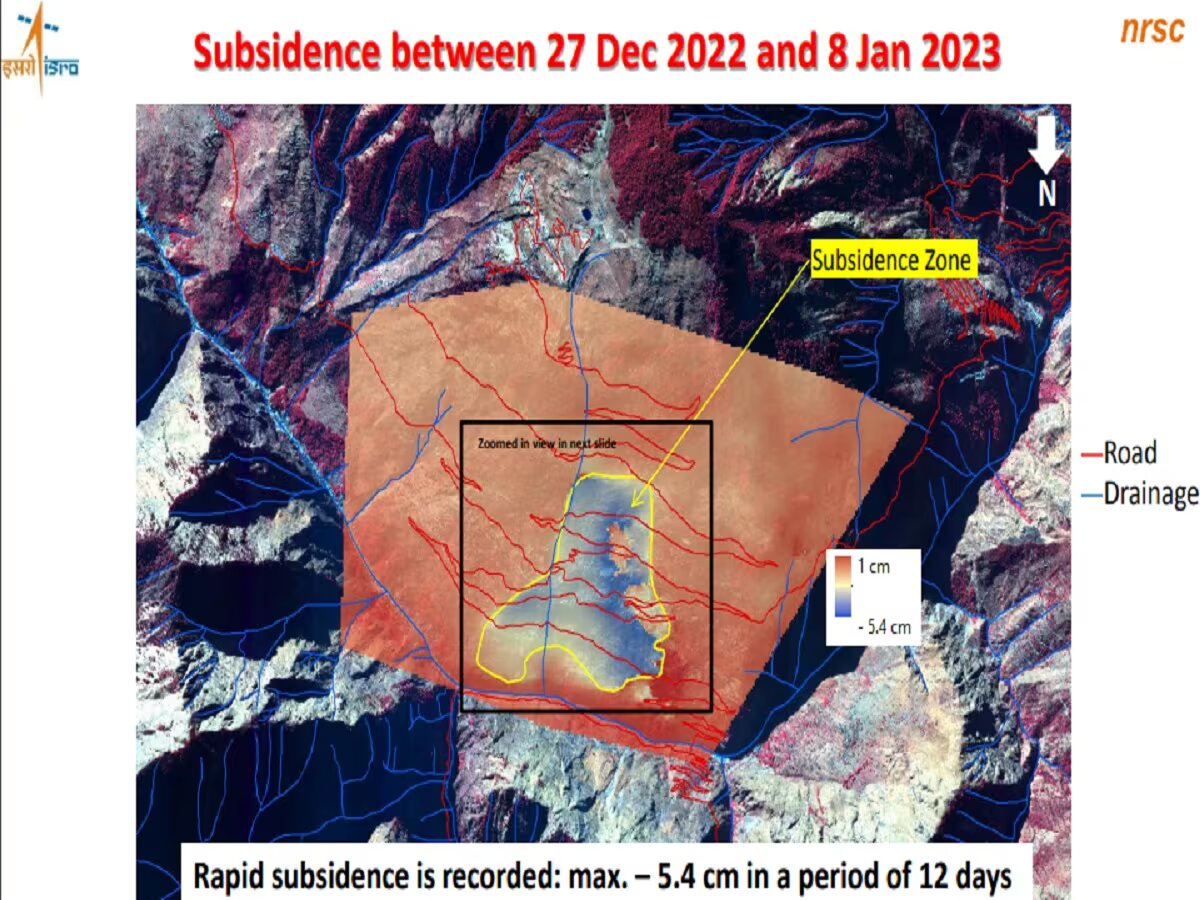Satellite images released by the Indian Space Research Organization (ISRO) revealed that Joshimath town in Uttarakhand sank at a rapid rate of 5.4 cm in just 12 days.
A study by ISRO’s National Remote Sensing Center (NRSC) said the land subsidence in Joshimath was slow between April and November 2022, during which the city sank by 8.9 cm. However, the preliminary study states that the intensity of the landslide increased between December 27, 2022, and January 8, 2023, and the city sank by 5.4 cm in these 12 days.
Images from the Cartosat-2S satellite showed rapid surface displacement over a span of a few days and an increase in the subsidence area. But it is confined to the central part of Joshimath city.
(Image: ISRO)
The subsidence area resembling the shape of a typical landslide was located at an altitude of 2,180 m near the Joshimath-Auli road with a thin top and wide base. The prominent sites in the concave area were the Army Helipad and the Narasimha Temple.
Joshimath landslide predicted in 2021
Meanwhile, the Indian Institute technology (IIT) Ropar said its researchers had predicted a massive landslide in Joshimath in 2021.
The study predicted displacements between 7.5 and 10 centimeters (cm) for buildings in Joshimath, enough to cause massive cracks in the buildings. Remote sensing data using Persistent Scatterer Synthetic Aperture Radar (PSInSAR) interferometry technique was used to investigate the sinking.
Explaining the process, Reet Kamal Tiwari, Assistant Professor, Department of Civil and Environmental Engineering, IIT-Ropar, said, “A signal from a SAR satellite interacts with various targets and travels back to sensors located in the satellite, Based on which an image has been created. Sentinel 1 SAR satellite data was used in our study.”
Constructed structures such as buildings act as continuous or permanent scatterers for active SAR sensors. Scatters refers to the change in direction of light because of its collision or interaction with another particle, including buildings.
Changes in the images taken over a period of time help in accurate identification. Tiwari said, “Since continuous scattering is generally not expected to move, therefore, any movement, even at the millimeter scale, can result from crustal deformation or seismic activity or even structural failure.” are captured accurately as they arise.”
The researchers initially examined the surface displacement of Tapovan, a tourist site near Joshimath, as a result of the February 2021 flash floods in Chamoli. It was observed that a surface displacement of up to 8.5 cm was being recorded at Joshimath which was upward.
Joshimath, being only 15 kilometers from Tapovan, was captured in satellite images, allowing scientists to go back in time and look at all the data till January 2020, this time to study the surface displacement of the town for.
The remote sensing data along with Artificial Intelligence (AI) algorithms were then used to predict the land subsidence in Joshimath. The study in which 16 images acquired using the PSInSAR technique from January 2020 to April 2021 were run through a machine learning model. The result predicted displacement of up to 8.5–10 cm in the near future, making the ground subsidence sufficient for the development of cracks in buildings.
“Currently, the displacement figures may be even higher and can be analyzed in more detail as more data is being added every 12 days with frequent satellite passes and ground displacements,” Tiwari said.
25 families evacuated, number rises to 185
According to the District Disaster Management Authority, Chamoli, 25 more families were rescued from their houses, taking the total number of families affected by the landslide to 185 in the town. It added that the number of houses that have developed cracks is 760, of which 147 have been marked unsafe.
Chief Minister Pushkar Singh Dhami said that the biggest priority of the government was to provide quick relief to the affected people and to take them to a safe place. He chaired a cabinet meeting during which several decisions were taken including a six-month waiver of water and electricity bills for the affected people and a one-year moratorium on recovery of bank loans.
It also decided to conduct a study on the carrying capacity of all the towns located in the hills. In the meeting, it was also decided to increase the amount given by the state government for payment of rent to the affected families from Rs 4,000 to Rs 5,000 per month. It is a matter of relief that each affected family living in temporary relief camps set up in hotels and residential units will be paid Rs 950 per room per day for accommodation and Rs 450 per person per day for expenses. Besides this, he would get Rs 80 per day to buy fodder for large animals and Rs 45 for small animals.
Chamoli District Magistrate Himanshu Khurana said that till now an interim assistance of Rs 1.5 lakh has been distributed to 42 affected families.
With the demolition operation being carried out under the technical supervision of Roorkee-based Central Building Research Institute, a large number of police personnel were deployed around the Malari Inn Hotel, which has developed huge cracks and is dangerously moving towards the adjacent Mount View Hotel. Leaning from
Union Home Minister Amit Shah on Thursday held a meeting of Union Ministers Nitin Gadkari, RK Singh, Bhupendra Yadav and Gajendra Singh Shekhawat and top officials to assess the situation in Joshimath and the steps taken to alleviate the difficulties of the people.
(With inputs from PTI)
read all latest india news Here
